TechRadar Verdict
While the DJI OM 4 was more of the same when compared to the Osmo Mobile 3, the OM 5 is a totally different direction for the series. It packs a smaller battery and no power bank functionality in favor of a much more refined, compact design, and some new selfie stick functionality. Interestingly, it’s less intuitive than the OM 4. Given the fact it extends, you need to be a bit more hands-on to get the most out of it, and things can get fiddly. That said, it also does more from a shooting point of view, and is in turn, a fantastic addition to the line, even if it isn’t a direct replacement for its predecessor.
Pros
- +
Versatile, compact phone gimbal
- +
New elegant design looks great
- +
Tracking feature improved
Cons
- -
OM 4 is better traditional gimbal
- -
Tricky to angle when on tripod
- -
Fiddly selfie stick extension
Why you can trust TechRadar
Two minute review
The DJI OM 5 follows on from the five-star OM 4 with a slick new design and a built-in extension rod, giving the well-respected smartphone gimbal line full-blown selfie stick functionality. And that’s all despite the fact it’s smaller and lighter than any of its predecessors – surely there's a catch? Indeed, it’s got a smaller battery, no power bank functionality and it’s a tad fiddlier. Still, it extends, which will be a crucial feature for many.
The first eye-catching aspect of the OM 5 is its look and feel. If the Osmo Mobile 3 and DJI OM 4 look like angry Autobots, the DJI OM 5 looks like it was heavily inspired by a pair of Bang & Olufsen headphones. Available in Sunset White and Athens Grey, even the colors look more luxurious than last year’s industrial grey options.
Like the OM 4, DJI’s latest iteration sports a magnetic clamp that lives on your smartphone, then latches onto the OM 5 for dear life when set near it thanks to a powerful magnet. If you’re big on vlogging, you can also pick up a new Fill Light Phone Clamp ($59/£42/AU$79), which sports two LED strip lights for some front camera video flattery. Versatile, even on larger phones like the iPhone 12 Pro Max and Motorola Edge 20 Pro, the clamp fits comfortably, even if you’ve got a case on your phone.
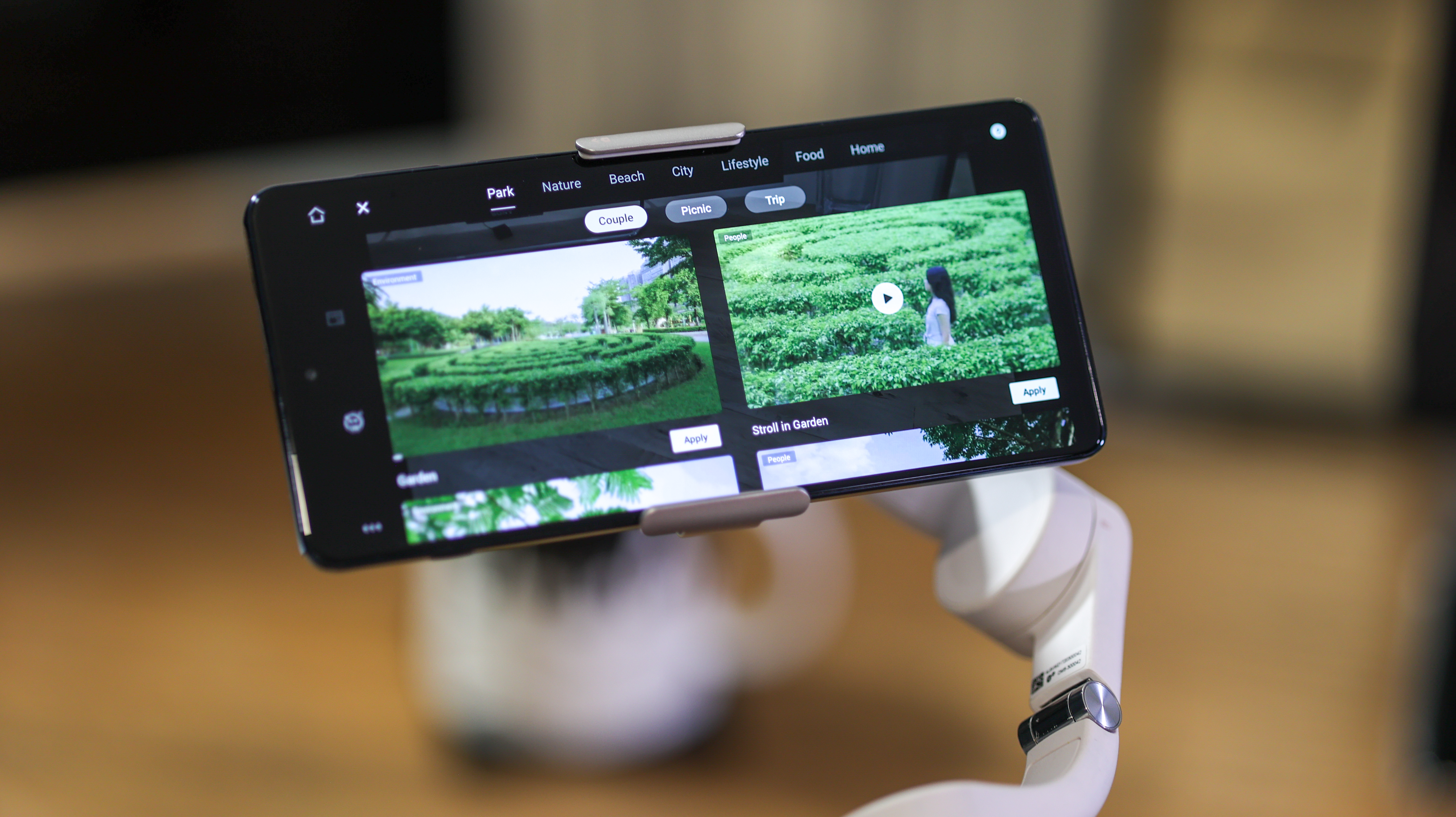
Unfold the OM5, and DJI brings back its 3-axis stabilization from previous generation gimbals. You can use the OM 5 out of the box with your phone’s native camera app. However, once you download the DJI Mimo app, you’ll be treated to a new ShotGuides feature, which walks you through capturing stylized clips. This isn’t too mind-blowing in practice for seasoned gimbal users, but is fun for newbies. That said, there’s also a new improved ActiveTrack 4.0 which works great and is clearly an improvement over past generations, and some new panorama photo enhancements.
DJI’s also brought back all the things that made last year’s OM 4 pop, including gesture Control, DynamicZoom (think the 'dolly zoom' vertigo effect in Jaws), Timelapse, Motionlapse, Hyperlapse, Spin Shot Gimbal Movement and Story Mode Templates.
Costing $159/ £139 / AU$239, the DJI OM 5 ships with a magnetic clamp, tripod, power cable, wrist strap and storage pouch. You’ll have to buy the Fill Light Phone Clamp separately for $59 / £42/ AU$79 if you want to get your flattering selfie game on with your OM 5.
All things said and done, it’s a great addition to the line, but it's not necessarily the best choice for everyone. The DJI OM 4 will remain on sale, but won't be manufactured anymore, so could be worth picking up if you don't need the extending arm. But the OM 5 sits alongside it for anyone who needs a turbo-charged, gimbal-stabilized selfie stick – and in that role, it's the best option around.
DJI OM 5 price and availability
- Available for $159/£139/AU$239
- Retail pack includes mini tripod, pouch and wrist strap
- Fill Light Phone Clamp sold separately
The DJI OM 5 is available from today for the same price the OM 4 was on launch, $159/ £139/ AU$239. Unlike past versions of DJI’s smartphone gimbal, the OM 5 ships with a mini tripod, pouch and wrist strap as standard, which helps justify the price that bit more.
While you get a metal clamp in the box, if you’re a vlogger or someone who needs your selfie lighting to be on point, you can also pick up a Fill Light Phone Clamp for $59/ £42/ AU$79. While it’s much heftier than the magnetic clamp, it adds a powerful light that operates at three strengths, and at three temperatures.
DJI OM 5: how does it compare?
- Gimbal and selfie stick combo like Smooth X
- Smaller and lighter design than OM 4
- Smaller battery and fewer ports than OM 4
The DJI OM 5 is like a lovechild of the DJI OM 4 and Zhiyun Smooth X. For anyone whose radar didn’t blip when the Smooth X launched, it’s a gimbal-and-selfie stick in one, aimed at vloggers. While the DJI Osmo Mobile 3 and OM 4 are three-axis gimbals, the Smooth X is just two-axis, making it fun, but less powerful.
This means, the DJI OM 5 could be the most powerful gimbal/selfie stick mashup around with its superior stabilization. That said, the mechanics of the OM 5 are similar to those Zhiyun’s gimbal in so far as you unfurl the folded up gimbal, then extend the arm quite clumsily to achieve some distance between your money maker and smartphone.
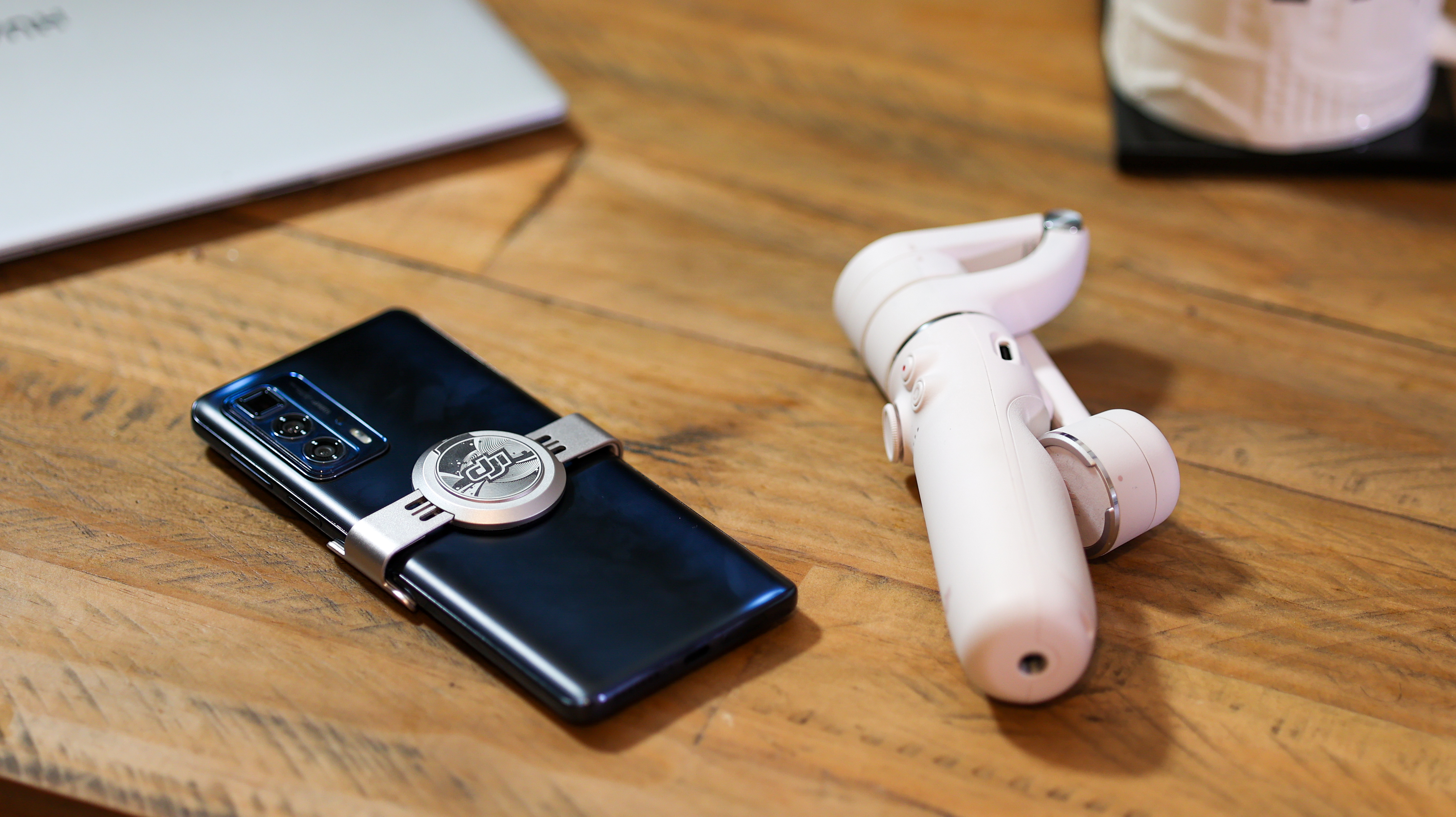
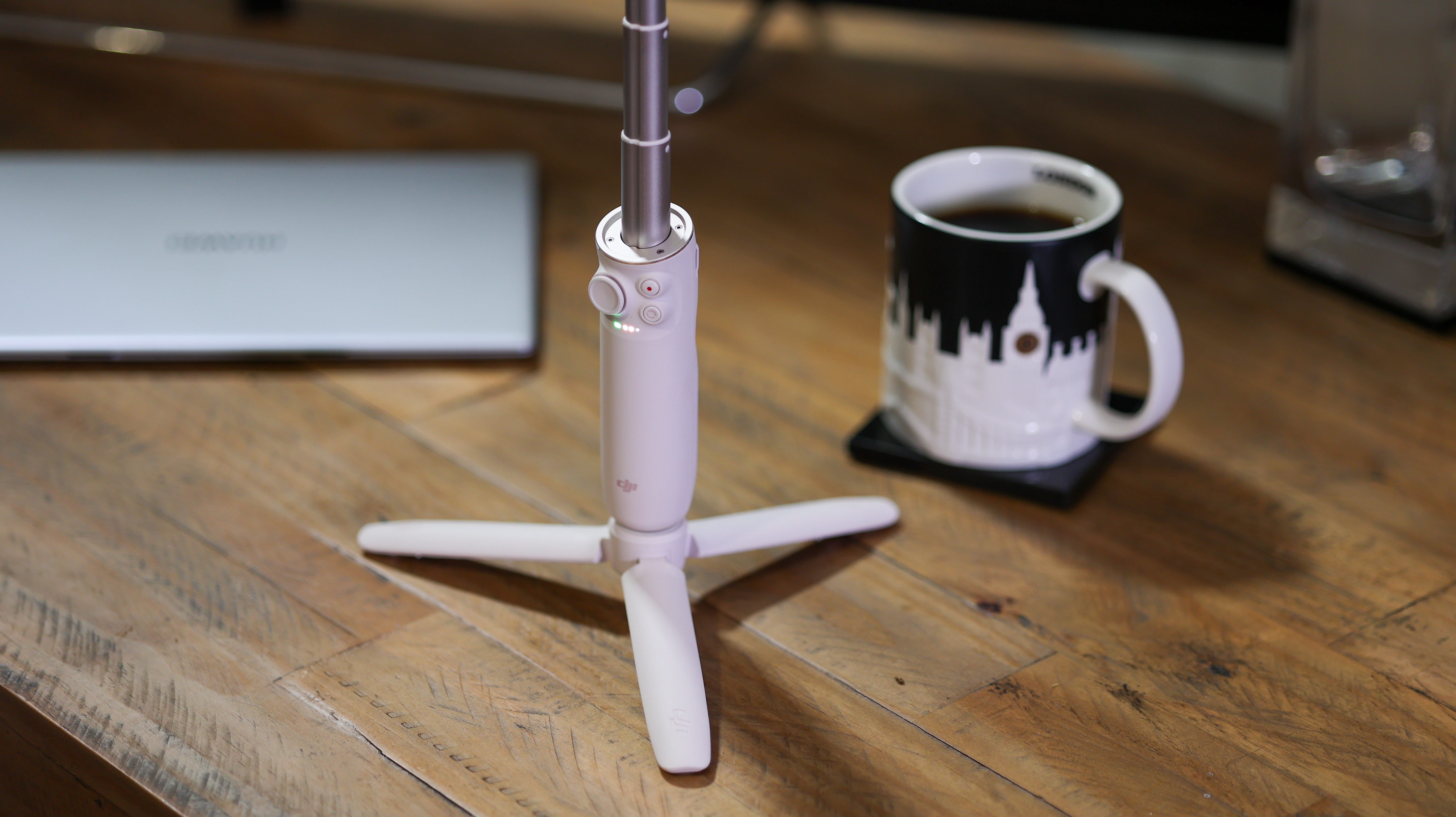
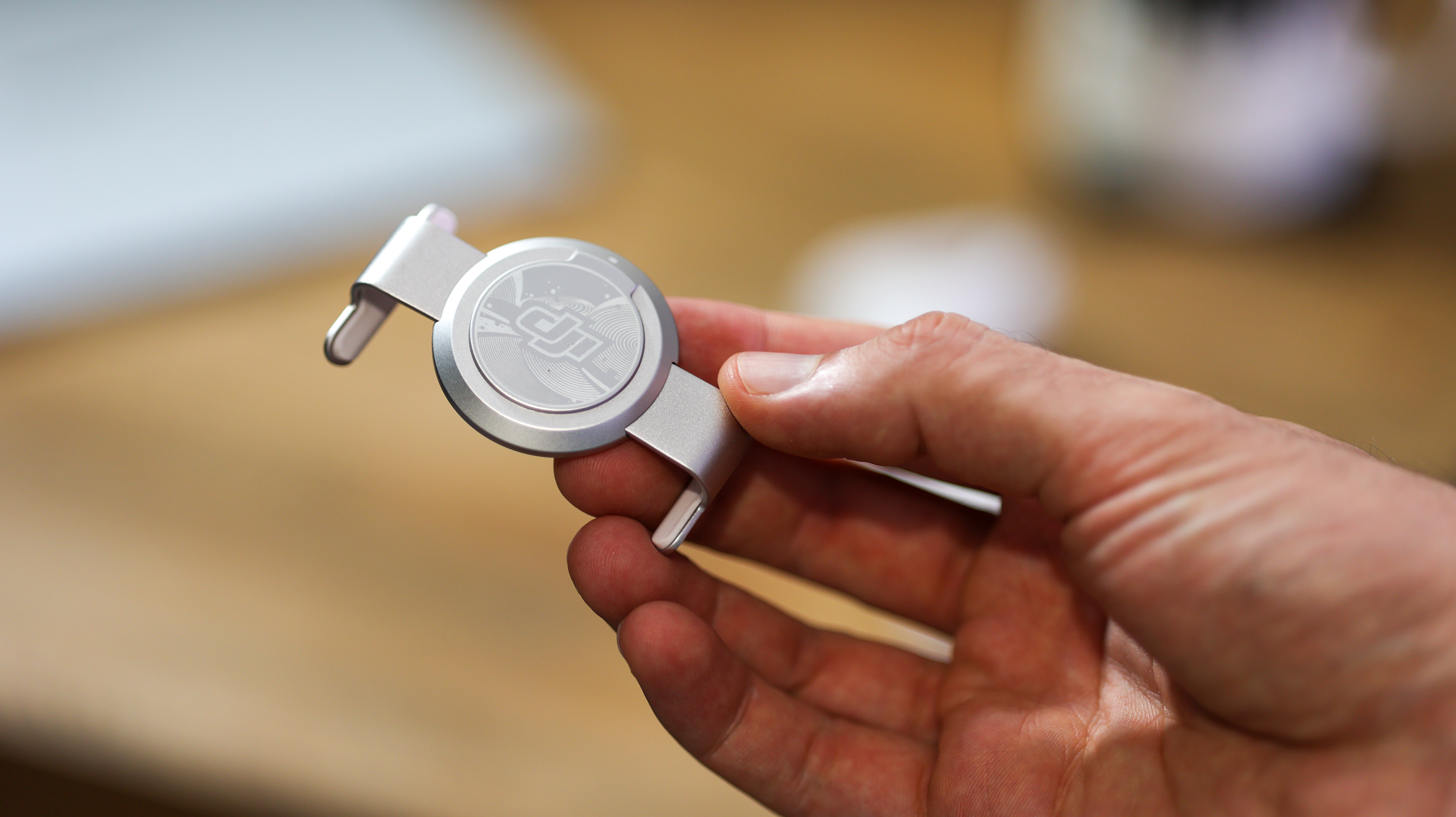
The first few times you use anything that folds, clicks into place, and twists as it transforms, it’s a clumsy fumble, but the DJI OM 5 became a relatively elegant solution to whip out after a few folds and unfolds. It’s also noticeably small and lightweight. It’s the actual stick extension that requires a bit of elbow grease and manual positioning.
The OM 5 weights around 100g less than last year’s OM 4 at 290g, despite the addition of the selfie stick arm. It extends by up to 21.5cm, so while far from the longest selfie stick around, it’s a wonder DJI managed to shave off so much weight. To be fair, a lot of that streamlining can be explained away by the smaller battery, which we’ll come onto later. The gimbal also doesn’t act as a USB-A smartphone charger, which its predecessor did, so there are fewer ports too.
Practically speaking, we’d say the fewer ports on the new OM 5 make sense, and help the series reach a new level of design excellence, even if the hardcore geek in us is sad to see some handy functions like reverse charging removed from the line.
Design
- Improved elegant, lightweight design
- Available in Sunset White and Athens Grey
- Fiddly selfie stick extension
If past generation DJI OMs and Osmo Mobiles have looked like computer game props straight out of Ready Player One, the OM 5 shakes things up, going in a much more organic direction. Its curves are soft, its shapes more natural than industrial, and one friend even joked it looks like an intimate aid.
Folded up, the OM 5 fits in a large pocket relatively easily, and poses no problem when sliding it into a backpack or a handbag. To unfold it, you simply rotate one portion, then flip another and you’re done. The magnetic grip lives on your phone, and adheres to the gimbal in a snap very securely.
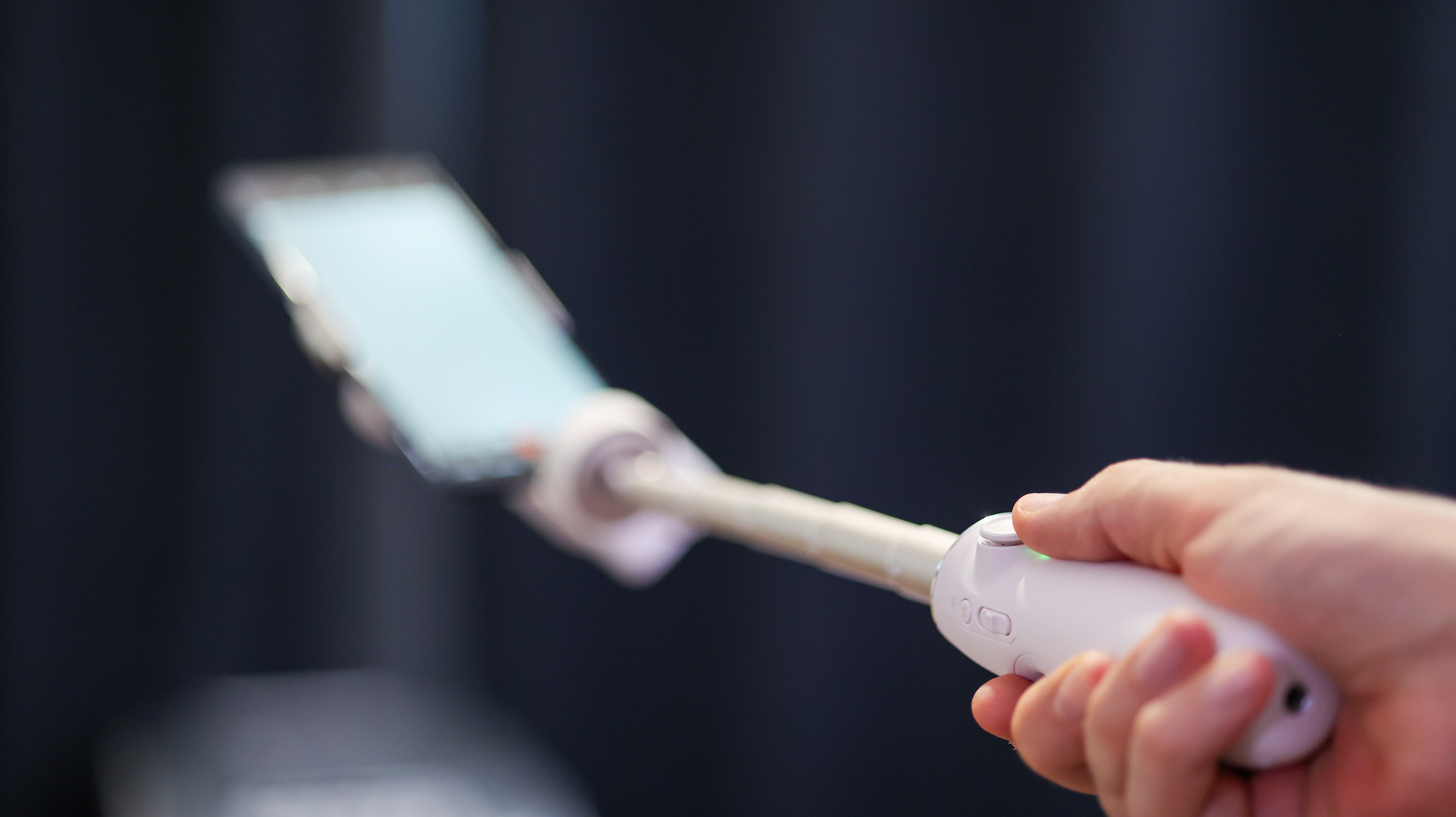
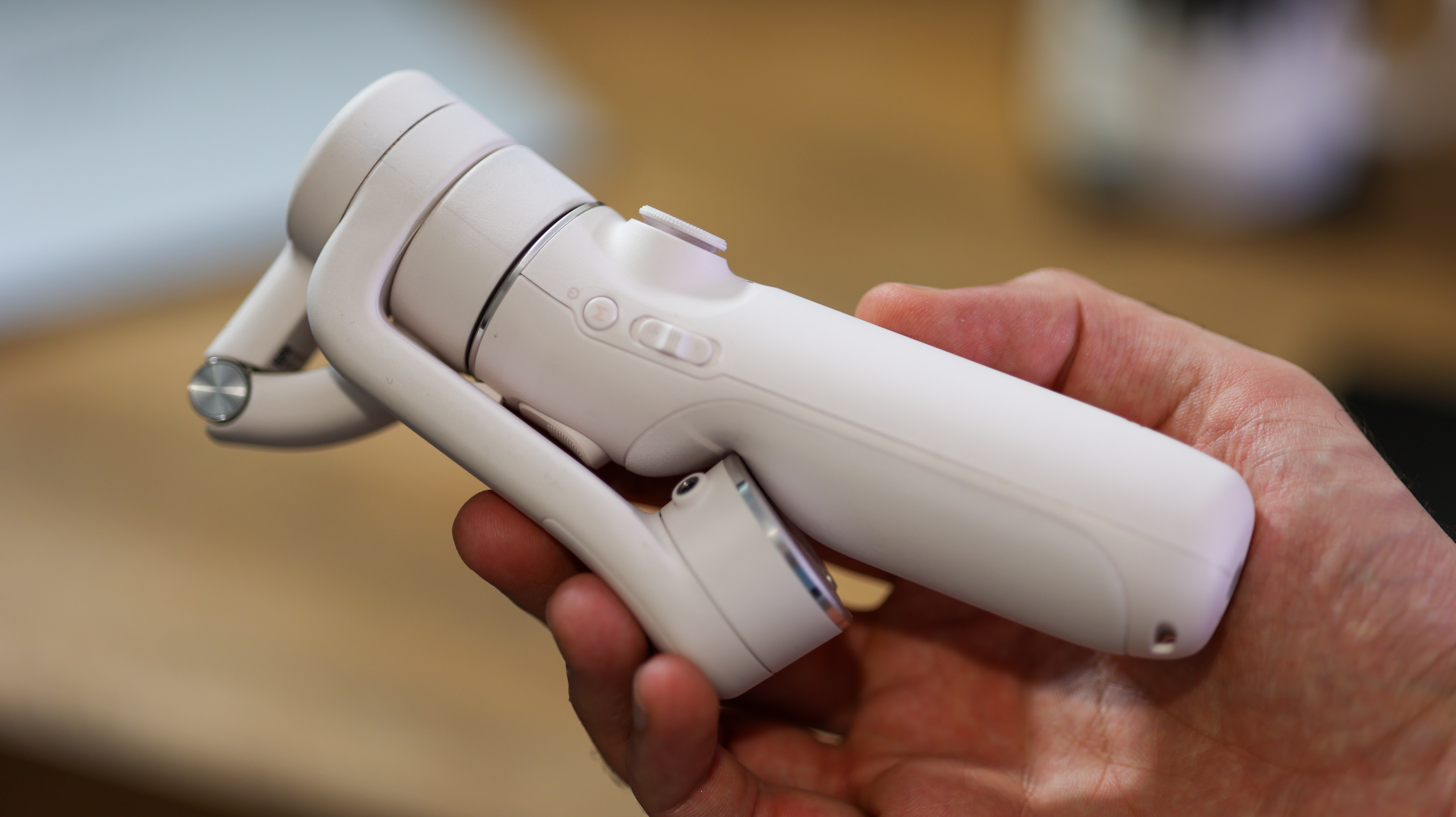
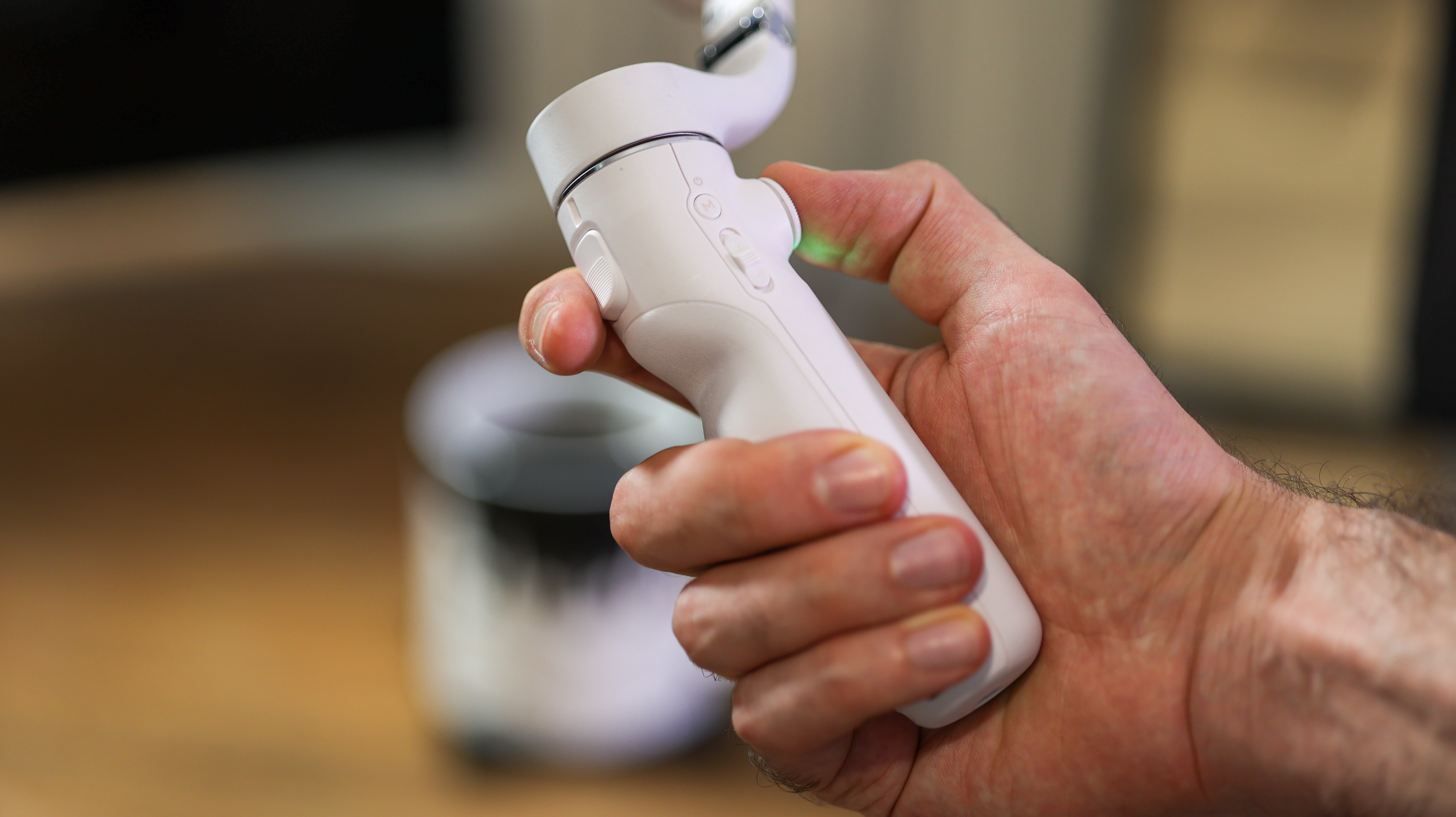
The base of the gimbal houses a standard 1/4-inch tripod thread; on the back of the gimbal is a joystick, a record and a rotate button. The rotate button can be pressed once to switch between front and rear cameras, and double pressed to flip from landscape to portrait orientation.
To the left of the main button interface is a zoom slider, which engages digital zoom through the DJI Mimo app, and a power button above it, which switches between photo and video shooting with a single press. On the front of the gimbal is a trigger that can reset the gimbal position, and finally, there’s a USB-C port for charging the gimbal.
As for the selfie stick feature, this is the most manual, clunky part of the OM 5 experience. To activate it, you simply yank the gimbal head away from the joystick portion and extend to your heart’s desire (up to 21.5cm). To really get the most from it, you should then pivot the head to angle you before you hit record, and as much as it can be a bit stiff to get in place, once set up, it all feels relatively secure.
Performance
- A good gimbal and a great selfie stick
- Intuitive, familiar controls
- Up to 6.4-hour battery life
You could certainly argue that the OM 4 is a better gimbal than the OM 5. While it doesn’t have the mega fancy extending arm, what it does do is operate as a more versatile gimbal when it isn’t extended.
What do we mean? The DJI OM 5 is made to be used both when it’s in selfie-stick mode and traditional gimbal mode. It therefore needs to be able to rotate differently to a gimbal that is always held at hand level. For traditionalists who don’t see themselves living their best selfie stick life, there’s very little reason to go for the OM 5 over the 4 if pure performance is what you’re after.
The gimbal undeniably does a great job of keeping footage nice and steady. Like the OM 4, it’s a three-axis system, so will pan, roll and tilt to compensate for hand movement. While the pan and tilt range are similar across last year’s DJI gimbal, this year’s, it’s the roll that’s different, with the DJI OM 4 rolling through -127.05-degrees to 208.95-degrees, and the OM 5 rolling through -136.7-degrees to 198-degrees. While both offer the same amount of movement, the OM 4 benefits from greater upward facing range, while the OM 5 benefits from greater downward facing range.

In other words, if you really want to get the most from the OM 5, firing up active tracking and using it as a makeshift camera person while it’s on a tripod, you can’t shy away from extending the arm, which might not always feel natural to do. If you don’t, you will be facing inferior useful reach when compared to the OM 4.
Speaking of rotation, when you’re using the joystick and are rotating your mounted smartphone, there’s a noticeable judder, especially if you have a slightly larger device. We also found the out of the box rotation to be pretty quick for our tastes. Slowing it in the DJI Mimo app both chilled out the erratic spins, and got rid of the judder.
As for the gimbal’s battery life, the OM 5 is powered by a 1,000mAh cell, which is significantly smaller than that of the OM 4, which was 2,460mAh. It therefore lasts around half the time. That's sad, but with around six hours of life from a single charge, we’re not too upset. Six hours of use time is plenty for a gimbal, and the fact it isn’t a portable power bank will mean that battery isn’t going to be shared with other devices.
DJI Mimo app
- Quick, easy pairing
- Improved object tracking
- Plenty of shooting modes
If you really want to get the most from the DJI OM 5, you’ll need to fire up the DJI Mimo app. Sure, you can use your smartphone’s native camera, but to engage with the on-body OM 5 controls (record, zoom etc), a load of shooting modes, and access object tracking, DJI’s app is your portal.
Once you download if from the AppStore or Play Store, you’ll be treated to quick pairing, once the OM 5 is fired up, and a home interface that gives you info about other DJI products.
As for modes, the OM 5 introduces a new ShotGuides feature, which walks you through capturing stylized clips. This isn’t too mind-blowing in practice for seasoned gimbal users, though can be handy for inspiration and is fun for newbies. The feature’s UI plays back a video in a floating window as you shoot that helps you position the gimbal just right, move it at the appropriate speed, and level up your clip capture.
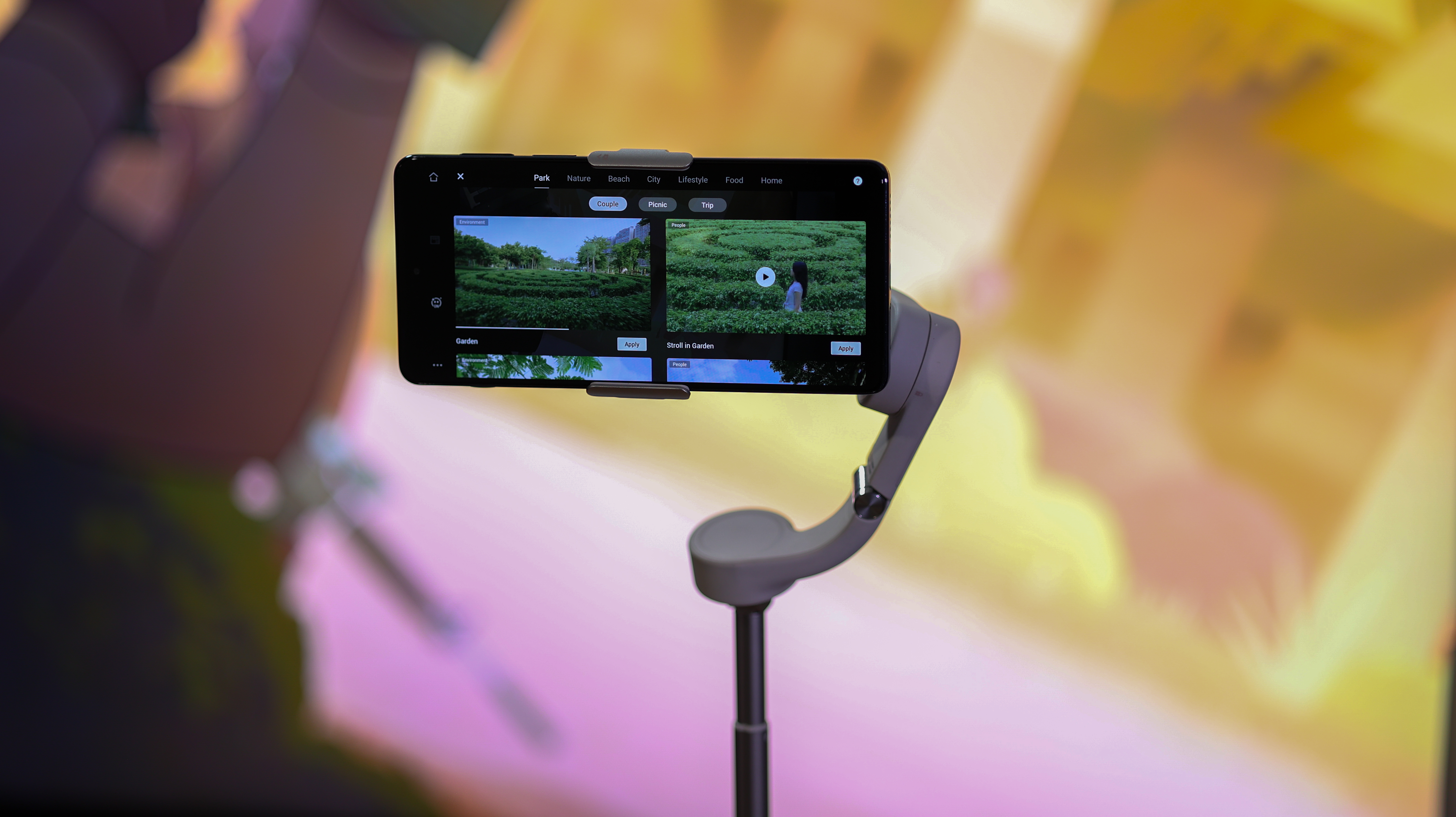
There’s also a new improved ActiveTrack 4.0 that works great and is clearly an improvement over past generations. Firing it up couldn’t be simpler; just drag a frame around the object you want to follow, and the OM 5 will keep it in frame beautifully. This works great when the gimbal is rested on a surface with its tripod attachment, and the arm is fully extended. This goes back to our comment about rotation; without extending the arm, the gimbal will struggle to angle up to face you, especially when on a low surface when tracking.
DJI has also brought back all the things that made last year’s OM 4 pop, including gesture Control, DynamicZoom (think the 'dolly zoom' vertigo effect in Jaws), Timelapse, Motionlapse, Hyperlapse, Panoramas, Spin Shot Gimbal Movement and Story Mode Templates.
Should I buy the DJI OM 5?
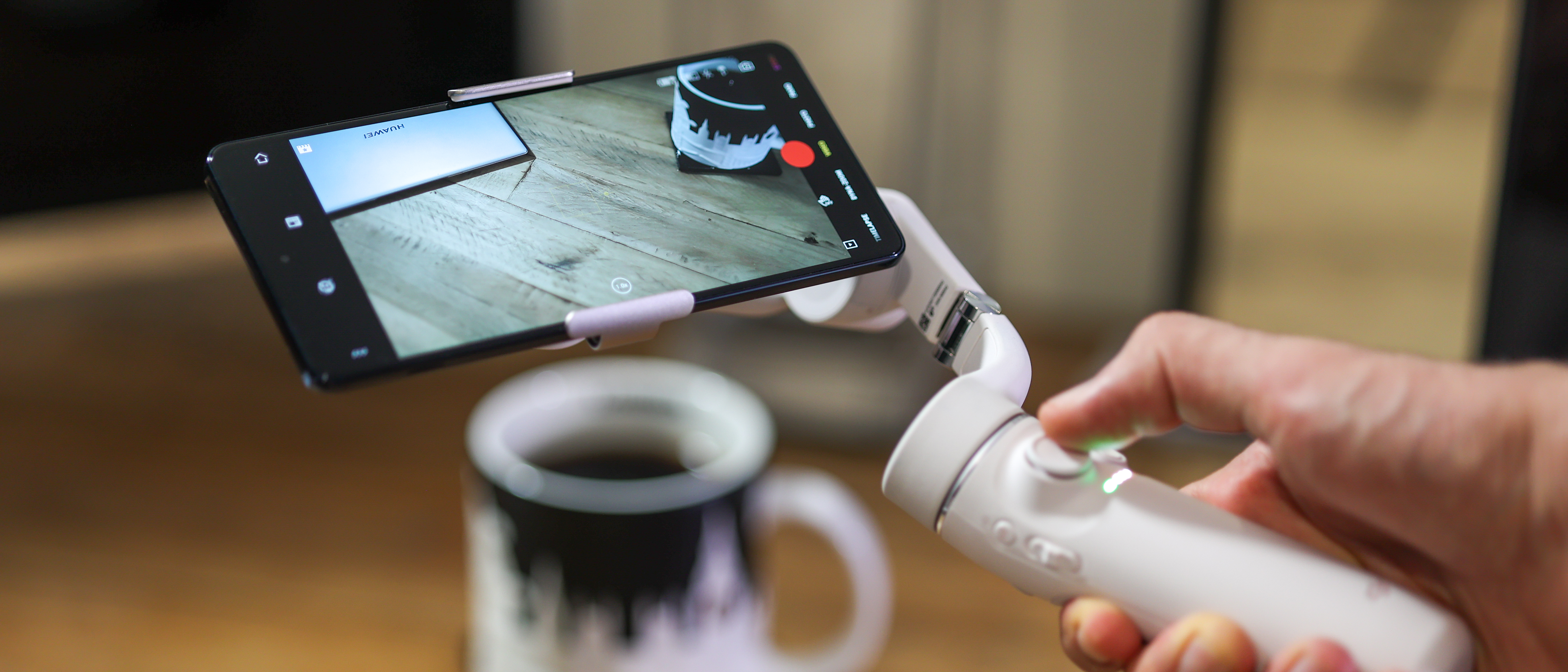
Buy it if...
You want the best selfie stick gimbal combo available
The DJI OM 5 is a great bit of convergence in a compact, fine looking package. It’s also handy if you’re a vlogger who loves some great selfie stick action with smooth stabilization.
You value the design of your tech accessories
Out of all the gimbals (or selfie sticks) we’ve tested, the OM 5 is without a doubt the best looking option available. While extending the stick can feel a touch clunky, the look and feel is as refined as gimbals get.
You want a truly compact, quality gimbal
Thanks to its smaller battery, fewer ports and refined design, the DJI OM 5 is 100g lighter than the OM 4, and when folded up, fits in a large pocket without too much trouble (provided you don’t mind part of it poking out).
Don't buy it if...
You don’t need selfie stick functionality
The DJI OM 4 packs a few great features that the OM 5 doesn’t; most notably, reverse charging, so it can double up as a power bank, and it also delivers much better battery life than this year’s model, lasting around 15 hours, versus the six hours of the OM 4. As a result, if you don’t need an extending arm, it could be the better option of the two.
You don’t mind a slightly larger gimbal
If you don’t mind some extra bulk, you could be better served with a DJI OM 3 or 4, two great alternatives, which will no doubt be available at a lower cost than the new OM 5. Yes, they’re bigger and don’t extend, but their stabilization capabilities match those of the OM 5 from a practical point of view.
You aren’t a fan of a grip that lives on your phone
The magnetic grip introduced on the OM 4 is back, and while it means your phone isn’t held hostage by your gimbal until you awkwardly unclamp it, it also means that there’s a grip that lives on your phone. If you’re a bit more old school and like an all-in-one gimbal system, then you might want to opt for the fixed-grip competition, like the DJI Osmo Mobile 3 or the Zhiyun Smooth Xs.
- These are the best vlogging cameras you can buy right now
Basil Kronfli is the Head of content at Make Honey and freelance technology journalist. He is an experienced writer and producer and is skilled in video production, and runs the technology YouTube channel TechEdit.
